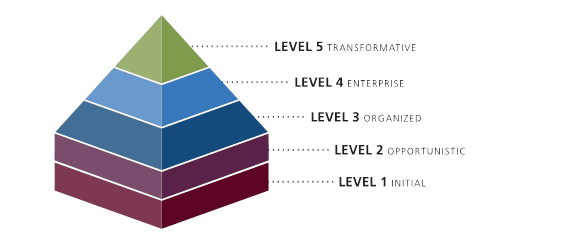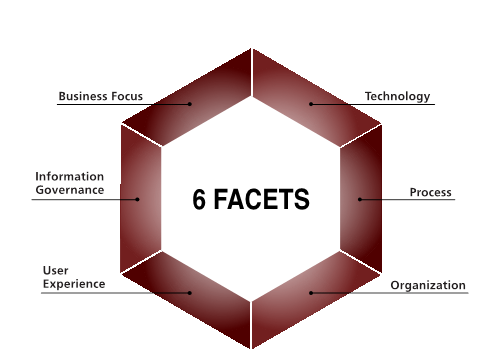Key Takeaways
- Texas A&M University sought to centralize and consolidate their various electronic content management solutions into single shared service.
- After selecting an ECM system, Texas A&M University planned for a successful rollout by using a five-level maturity model and a multidimensional definition of scale.
- The model and broader definition allow Texas A&M to measure progress and align the ECM system with institutional goals as it scales enterprise-wide.
Over time, agencies and colleges within The Texas A&M University System invested in electronic content management systems to improve efficiencies and reduce costs of operations. Faced with multiple vendor-supplied ECM and homegrown departmental solutions, the university decided to centralize and consolidate future implementations using a strategic approach. Following evaluation of options, the university assigned Texas A&M Information Technology as the central support for the preferred ECM technology.1 Texas A&M IT established a shared service approach to the delivery of the technology and pursued a maturity model to guide scaling its operations across the A&M System.
Video courtesy of Laserfiche
In this video (2:49 minutes) author and ECM project manager Judith Lewis explains the process and results of rolling out a new ECM system.
Context
The Texas A&M University System is one of the largest systems of higher education in the United States. The A&M System is a statewide network comprising 11 university campuses, seven state agencies, and a comprehensive health science center. Through the efforts of more than 28,000 faculty and staff, the A&M System educates more than 120,000 students each year. The A&M System reaches another 22 million people through its service efforts and has a physical presence in 250 of the state's 254 counties. In 2011, externally funded research expenditures exceeded $780 million.
Early Adopters of ECM
In 2005, Texas A&M AgriLife wrote an RFP for an ECM system. The RFP team included not only IT personnel but also an economist and representatives from the College of Agriculture and Life Sciences Departments, the AgriLife agencies, and AgriLife Purchasing. The team developed a selection matrix for evaluating competing products, with cost as a major factor in the decision tree. Upon selecting a vendor, Texas A&M AgriLife implemented its ECM in three phases:
- Phase 1: Basic installation, file structure, and imaging
- Phase 2: Automation from mainframe
- Phase 3: Workflow
During Phase 2, Texas A&M AgriLife automated processing of documents from legacy mainframe systems directly into the Laserfiche ECM for accounts payable, purchase orders, and payroll change forms. A hurricane in 2009, the collapse of a storage building roof as a result of storm damage in 2010, and a fire in 2011 that resulted in smoke and water damage to multiple documents (see figure 1) added urgency to digitizing records and having off-site backup storage. Currently, Texas A&M AgriLife electronically stores close to 14 million document pages.

Figure 1. Physical damage to files demonstrates the need for electronic records
As news of Texas A&M AgriLife's success spread through the A&M System, other units followed their example, selecting vendors, implementing ECM systems, and leveraging the digital document management benefits for their departments and agencies.
By 2009, the A&M System had multiple ECM implementations, including homegrown solutions, several different vendor products, and even separate implementations of the same product. That year, the flagship campus instituted the Campus Document Management Committee to evaluate the three predominant ECM vendors on campus with the intent of identifying a preferred vendor for future implementations. The committee had three main goals:
- Avoid software/hardware purchases at the department level.
- Reduce costs by eliminating redundant systems.
- Enhance the ability to share documents and workflows.
The history of selecting and scaling an ECM system at Texas A&M University — the why, what, and how — is detailed next.
From Silos to a Shared Service
In 2010, the Campus Document Management Committee selected Laserfiche for future ECM implementations. Further, the committee recommended that a single, central support service be provided to offer an enterprise implementation of that service. The university president signed a campus memo approving the committee's recommendations. Because Texas A&M AgriLife's limited resources did not allow supporting an expanded A&M system-wide enterprise application, Texas A&M IT at Texas A&M's flagship campus was chosen to offer the shared service. Texas A&M AgriLife, with 1,300 users, which had been contemplating upgrading its own enterprise implementation, seized the opportunity to move their implementation into the shared service to realize cost savings.
Video courtesy of Laserfiche
In this video (2:36 minutes) author Bob Hensz explains the importance of collaboration in achieving a gain-gain situation across departments.
Using a Multifactored Definition of Scale
With a large and growing user base for the newly inaugurated ECM shared service, the institution leveraged the benefits of research in developing its plan to scale its operation to the A&M System. In a peer-reviewed article published in 2003, "Rethinking Scale: Moving Beyond Numbers to Deep and Lasting Change," Cynthia Coburn described a multidimensional definition of the term scale.2 Her definition of scale for social and educational projects expanded conventional concepts to encompass more than increases in units, which she refers to as spread, to include changes in group assumptions, behavior, and responsibility in the organization, which she encapsulated in the terms depth, sustainability, and shift in reform ownership.
In preparing to roll out the Texas A&M enterprise shared service, author and ECM project manager Judith Lewis sought to address this multidimensional definition of scale to achieve a successful rollout. While each factor needed to be addressed, the project needed a mechanism to assess progress in each area. Lewis turned to a published maturity model to judge the shared service's status and progress.
Leveraging a Maturity Model to Achieve Scale
The vendor's implementation documentation provided a straightforward five-factor model with commonsense recommendations to identify local best practices and standardize across the ECM, all while consolidating resources, realizing cost benefits, and continuously looking for ways to improve the service.3 An effort to track the progress of such a maturity model against some kind of rubric led to the discovery of a multilevel, multifaceted approach developed by Gartner.
In 2011, Gartner published an updated maturity model for ECM implementations.3 This model is based on a five-level approach to the advancing competencies in ECM (figure 2).

Source: Texas A&M Information Technology
Figure 2. Five-level ECM implementation approach
Each successive level, starting with Initial, progressing through Opportunistic, Organized, and Enterprise, and ultimately achieving Transformative, is evaluated against characteristics for that level in each of six facets (figure 3).

Source: Texas A&M Information Technology
Figure 3. Six facets of evaluation for each of the five ECM levels
An organization commonly occupies different levels for the various facets, evaluating its level of maturity against the expected accomplishments for that level in each of the six facets. The maturity model thus suggests that organizations address those facets in which they demonstrate the lowest maturity in order to move up in overall maturity.
The following sections describe Texas A&M's ECM progress against the Gartner maturity model.
Level 1: Initial
At the Initial level, the organization addresses its document management needs in isolation, without regard for the impact that the resulting siloed approach has on the institution. By the end of 2009, in the A&M System each installation of document management operated as a separate silo. The A&M System had entered into contracts with multiple vendors for the same service. There were multiple implementations in operation, but interaction between systems was almost nonexistent. As the individual silos matured, those agencies and departments looked for ways to bridge the gaps between legacy systems and their implementation by establishing process and policy (IT governance). In this way, the A&M System began to move toward the next level, Opportunistic, as it moved toward creating a true enterprise ECM.
Level 2: Opportunistic
Moving beyond initial engagement with enterprise content management, the organization finds a strategic focus for its implementation, addressing specific problems and business initiatives. While successful implementations remained siloed, Texas A&M leveraged its collective document imaging expertise to establish a committee with the express directive to spot opportunities to consolidate the university's investment in digital imaging management. With the committee's 2009 recommendations, the university looked to the next level, identifying a list of requirements and a vendor for consolidation based on strategic needs. The next step was to organize a steering committee to act as a two-way avenue to disseminate information about the ECM and to obtain feedback for further improvement.
Level 3: Organized
At the Organized level, the organization should address enterprise-wide challenges. The university identified a central support provider, Texas A&M IT, for the shared services initiative in 2010. A project manager was assigned and a steering committee formed in 2011. The ECM team at this stage had long-range plans, but multiple products and implementation repositories still existed.
In order to move to the next level, the ECM team must report progress regularly to build support. To that end, Texas A&M IT established a brand for the enterprise Laserfiche ECM with signature colors consistent with both the university's and vendor's style guides. Using the consistent naming and branding in presentations, publications, and messaging, the project team sought to build recognition for the service and report on its rollout. A university website developed as a go-to location for outreach and training was also branded consistently with the shared service.
Training covering fundamentals of the document management software was developed in concert with the university's Employee and Organizational Development department to standardize the foundational education. In addition to teaching how to use the tool, the three-hour training class includes short segments on the A&M System requirements for security and the document retention schedule.
Consistent with the recommendation to look for areas of collaboration to integrate ECM with business process, the Texas A&M ECM team evangelizes the benefits of metadata through training and collaboration. Additionally, opportunities are identified with colleagues to leverage the ECM in reengineering business processes.
Level 4: Enterprise
At the Enterprise level, the ECM is integrated with the organization's IT strategy. Texas A&M negotiated a master agreement with the Laserfiche Corporation to enable a move from a single server with a multiple, but limited, repository implementation of its ECM to a multiserver, scalable system. (The steering committee contributed to the requirements-gathering process for the master purchasing agreement.)
The university currently seeks to use the steering committee to create IT governance principles and identify best practices for the A&M System. In addition, the ECM team, in collaboration with the steering committee, seeks to consolidate overlapping projects to facilitate the shared ECM service and encourage better use of metadata for retrieval and reporting, especially through automated processes.
Level 5: Transformative
At the highest level, Transformative, ECM fundamentally changes the way the organization does business; not all organizations will achieve this level of maturity. Through feature awareness and exchange of experiences, the shared service can leverage exemplar processes to the benefit of new adopters. At Texas A&M University, departments are using ECM to reengineer business processes to provide a paperless approach to doing business. The expanding use of a common ECM platform allows for intra-departmental document access and workflow-driven operations, many of which were previously paper-based processes.
In addition, business and vendor partnerships should be turned into collaborations for future vision and planning.4 As part of Texas A&M 's work to achieve the Transformative level, a close working relationship was forged with the vendor. A long-term master agreement was negotiated that allows Texas A&M to incorporate industry best practices as the shared service scales while securing pricing that gives individual departments access to the ECM at a price not possible on an individual basis.
Applying Coburn's Aspects of Scaling to the Maturity Model
The defined levels of Gartner's maturity model as applied at Texas A&M were supplemented by Coburn's research described above. Each of the four characteristics outlined — spread, depth, sustainability, and shift in ownership — is addressed briefly.5
Texas A&M is increasing the shared service's spread by making more licenses available and storing more documents in digital repositories. It has embarked on a three-year plan to scale the shared service through a master agreement with the vendor.
Texas A&M has also reached a depth of commitment among their potential user market through outreach and discovery sessions aimed at scaling the shared service, not through imposition but by adoption based on the merits of the service.
In addition, the shared service has progressed from a committee decision with C-level support through branding, outreach, and value delivery to a movement with sustainability of common purpose and benefit.
Finally, the localized successes have led to a shift in ownership from a top-down recommendation to grassroots involvement with spontaneous collaboration between groups and local initiatives to move unit successes into a shared service to broaden the benefit base.
What's Next
Texas A&M is in the first year of a projected three-year plan to expand the service from 1,300 to to 4,400 users. At this point, the steering committee, master agreement, training, and infrastructure are in place for extending the shared service. The focus is now on increasing spread while fostering the depth, sustainability, and shift in ownership that Coburn's research shows to be crucial to successfully scaling projects.
To specifically address those dimensions for the shared service, Texas A&M is focusing on broadening fundamental skill sets as well as providing enhanced training to demonstrate more advanced techniques, widening the localized expertise through a community of practice, and negotiating IT governance through a closely involved steering committee.
Conclusion
The Gartner maturity model demonstrates that scaling an ECM takes planning, work, and continual refinement. This approach, coupled with a multidimensional definition of scale, has led to a demonstrable way to assess Texas A&M's ECM project progress while supporting A&M's vision and goals. Texas A&M is projected to expand the shared ECM service to 4,400 users within the three-year plan.
- The president signed off on a memo approving three products for use in existing implementations, but Laserfiche was the "preferred" product for all new implementations. Departments wanting to use something other than the preferred vendor must get approval from the Office of Vice President and Associate Provost for Information Technology.
- Cynthia E. Coburn, "Rethinking Scale: Moving beyond Numbers to Deep and Lasting Change," Educational Researcher 32, no. 6 (2003): 3–12.
- See Laserfiche's 2010 publications GRC: A Framework for Organizational Sustainability and ECM Agility for Higher Education: Harnessing Technology to Achieve Institutional Efficiency and Responsiveness; also see Bob Hensz and Judith Lewis, Scaling a Higher Education Enterprise Electronic Content Management (ECM) System, presentation at EDUCAUSE 2012, November 6–9, 2012, slide 10.
- Gavin Tay and Kenneth Chin, "Maturity Model for Enterprise Content Management," Gartner Research Note G00213197, June 13, 2011.
- Ibid.
- Coburn, "Rethinking Scale."
© 2013 Texas A&M University
